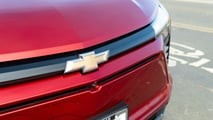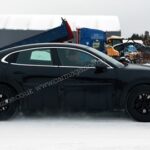After six months and 1,200 miles behind the wheel of the 2024 Blazer Ev, it’s time for an honest assessment. My journey with this electric SUV, nicknamed Gorbo, has been a mix of pleasant surprises and minor frustrations. From a road trip to Bryce Canyon National Park that tested its range in below-freezing temperatures to everyday errands, the Blazer EV has proven to be a capable and practical vehicle. However, like any car, especially a first-year EV model, it’s not without its quirks. This long-term review dives deep into the real-world ownership experience of the 2024 Blazer EV, covering everything from its impressive features to areas that could use improvement.
What Shines in the 2024 Blazer EV Experience
The daily driving experience with the 2024 Blazer EV is genuinely enjoyable. My model, a 2024 LT AWD (comparable to today’s 2LT), came with launch edition perks and offers a refined and quiet ride. The integrated software is a standout feature, making it feel modern and intuitive.
Space is another significant advantage. During our 1,200-mile road trip from San Diego to Utah, the Blazer EV swallowed an impressive amount of gear. Camping equipment, coolers, tables, chairs, extra clothing – it all fit with room to spare. We even slept comfortably in the back, which is surprisingly spacious, easily accommodating two adults under 5’7″.
 Radiant Red 2024 Chevy Blazer EV LT: Front three-quarter view showcasing its stylish design in a long-term owner review.
Radiant Red 2024 Chevy Blazer EV LT: Front three-quarter view showcasing its stylish design in a long-term owner review.
The tech integration, particularly the built-in Google Maps, is a game-changer. It eliminates the need for phone-based navigation systems like Apple CarPlay, which I haven’t missed at all. The seamless integration means no more dropped connections or constant phone dependency. I can even run errands without my phone and still access Spotify and navigation, a convenience I appreciate.
Ground clearance is another unexpected but welcome benefit. With 7.9 inches of clearance, the 2024 Blazer EV sits higher than most mainstream electric SUVs. This surpasses competitors like the Hyundai Ioniq 5 and Kia EV6, which offer a more car-like 6.1 inches. Even Jeep’s initial EV offering falls short with 6.4 inches. This added ground clearance, combined with the generous cargo space and roomy back seats, makes the Blazer EV an ideal electric SUV for those who enjoy outdoor adventures, like camping or hiking on light trails with friends and family.
 Chevy Blazer EV ground clearance demonstrated on a dirt road, highlighting its off-pavement capability in an owner review.
Chevy Blazer EV ground clearance demonstrated on a dirt road, highlighting its off-pavement capability in an owner review.
For those needing even more off-road capability or cargo space, options like Rivian, electric G-Wagen, or electric pickups exist, but they come at a significantly higher price point. The 2024 Blazer EV strikes a good balance between capability and affordability.
Areas of the 2024 Blazer EV That Are Just Acceptable
The EPA-estimated range for my 2024 Blazer EV LT AWD is 279 miles. While acceptable for its class, it does require some adjustments for road trips. Realistically, you rarely deplete the battery to zero or charge to 100% daily. The Blazer EV’s range prediction tends to be conservative, which, while reassuring, can also lead to range anxiety in certain situations, like my Bryce Canyon trip.
In practice, this conservatism meant arriving at charging stops with around 20% battery remaining. Given the slower charging speeds and reduced charging rates above 80%, effectively only about 60% of the battery capacity was regularly utilized. This translated to roughly 160-180 miles between charging stops, with charging sessions averaging around 35 minutes.
While the range is comparable to AWD versions of the Kia EV6 or Hyundai Ioniq 5, and a longer-range RWD variant of the Blazer EV is available, longer road trips would benefit from a closer to 350-mile EPA range. However, for typical use, and acknowledging that most drivers don’t undertake frequent long road trips, the range is adequate. The more frequent stops on road trips also meant arriving at destinations feeling less fatigued compared to enduring longer, non-stop drives.
 Waiting in line at a crowded EV charging station during a road trip in the 2024 Chevy Blazer EV, illustrating charging infrastructure challenges.
Waiting in line at a crowded EV charging station during a road trip in the 2024 Chevy Blazer EV, illustrating charging infrastructure challenges.
Driving dynamics are satisfactory but not thrilling. The 2024 Blazer EV is a substantial crossover, prioritizing comfort over sporty handling. Its 288-horsepower powertrain, producing 333 lb-ft of torque, delivers ample power for daily driving and quick acceleration from a standstill. However, its weight becomes noticeable when pushed harder, lacking the agility of lighter vehicles. Handling in corners is competent, better than some competitors like the Toyota RAV4 or Ford Escape, but it’s not designed for spirited driving.
Similarly, the sound system and seats are decent but not exceptional. The cabin is quiet and the ride is smooth on highways, but the standard speakers and seats are average. While the seats were comfortable enough for the 1,200-mile trip, a higher-quality audio system and more luxurious seats would elevate the overall experience, perhaps something closer to what the Cadillac Lyriq offers.
Frustrations with the 2024 Blazer EV Ownership
The MyChevrolet smartphone app is a significant pain point. It’s slow, often taking up to a minute to update the state of charge, and remote start commands frequently fail. Workarounds like sending a lock command first or using the MyBuick app (which seems more reliable) offer slight improvements, but the overall app experience is clunky and lags far behind Tesla’s app in terms of speed and reliability.
Using the MyChevrolet app to access Tesla Superchargers, despite GM’s official support, is also cumbersome. The native Tesla app is significantly more user-friendly and consistent. Ideally, GM EVs would support automatic payment and charge initiation at Tesla Superchargers, similar to Rivian and Ford, eliminating the need for third-party apps.
Accessing the Tesla Supercharger network, while beneficial for charging availability, comes with an awkward user experience for non-Tesla vehicles.
 Radiant Red 2024 Chevy Blazer EV LT: Front three-quarter view showcasing its stylish design in a long-term owner review.
Radiant Red 2024 Chevy Blazer EV LT: Front three-quarter view showcasing its stylish design in a long-term owner review.
Due to the Tesla Supercharger cable length and station design, parking the Blazer EV often required taking up two stalls or parking on gravel to reach the charging port. This is not GM’s fault but rather an inherent issue with the Supercharger network’s design around Tesla vehicles, leading to a less than ideal charging experience for other EV brands. Newer V4 Supercharger stations with longer cables that can reach either side of the car offer a glimpse of a more user-friendly future.
Charging times can also be lengthy. Even with a 350-kW charger, a 10-80% charge can take 40 minutes under optimal conditions. Cold weather further impacts charging times and range.
The Bryce Canyon trip highlighted the impact of cold weather on range. Despite starting with a 100% charge and planning a 160-mile round trip with minimal in-park driving, near-freezing temperatures and elevation gains significantly reduced efficiency and increased range anxiety. For road trips in cold climates, especially in rural areas, more range is definitely desirable.
Finally, quality control issues have been a recurring concern. A persistent rattle from the headliner, even after a replacement, and a panoramic moonroof that frequently malfunctions, requiring multiple attempts to close, are ongoing issues that necessitate further dealer visits. These issues have already resulted in three service appointments within the first six months of ownership, which is more than expected for a new vehicle.
Overall Impression of the 2024 Blazer EV
Despite these shortcomings, I remain largely satisfied with the Blazer EV, primarily due to its value proposition. The lease deal makes it an affordable entry into the EV SUV segment.
The ownership experience isn’t seamless. Road trips require more planning and aren’t as effortless as with a Tesla. Adapters are necessary for some charging networks, third-party route planners are recommended, and potential quality issues need to be considered.
However, the 2024 Blazer EV delivers on its core promises: a comfortable, stylish, and highly practical SUV at a reasonable price. There’s a learning curve associated with EV ownership, and the Blazer EV experience reflects that. It’s not a perfect replacement for a traditional gas car paradigm, but it’s a compelling step in that direction.
The Blazer EV also highlights areas where GM needs to improve as it expands its EV lineup, particularly in software, charging infrastructure integration, and overall vehicle quality.
Yet, the advantages are undeniable. Lower running costs, a quieter and smoother driving experience, and modern, smartphone-era technology make the Blazer EV appealing. It fosters optimism about the future of EVs. The current EV ownership experience, even with its imperfections, is still quite positive and is only expected to improve. It requires some adaptability, curiosity, and a willingness to improvise, but it’s ultimately an engaging and rewarding experience. The 2024 Blazer EV is an adventure in EV ownership, and it’s a ride worth taking.
